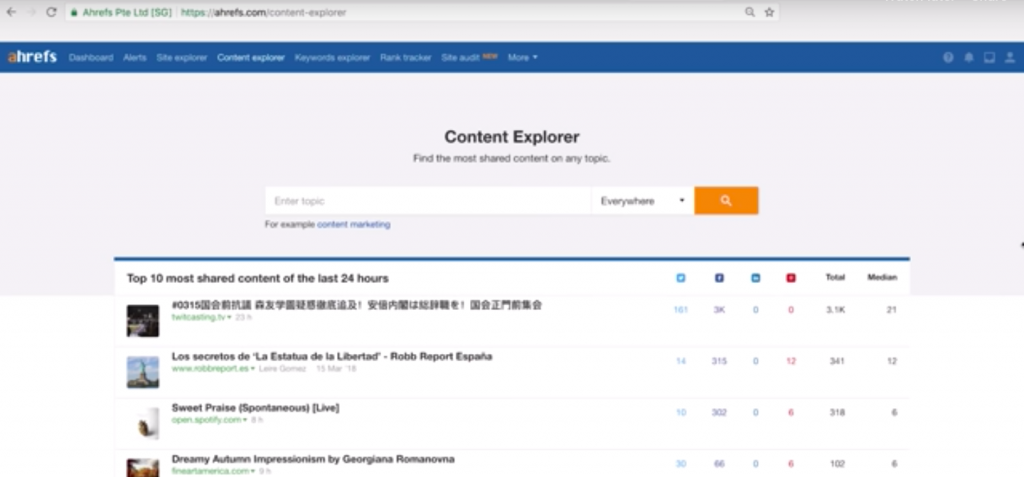5 Everyday SEO Metrics That Are Best Tracked Using Ahrefs
Tracking your SEO efforts is integral to the success of any company.
A properly executed SEO plan takes time and money, and in order to make sure it’s worth it, you need to make sure there’s a decent return on your investment.
SEO tracking is the wonderful world of measuring your SEO performance. Companies of all shapes and sizes have begun to dedicate healthy portions of their budget to this endeavour, and it’s no wonder – one of the biggest advantages to digital marketing is that nearly every part of your strategy is measurable.
That means you can easily see what’s working and what isn’t, and change your plan accordingly. Of course, you need the right tools to start.
Ahrefs is one such tool. The Singapore-headquartered company’s roots stretch back to Ukraine where the company began operating in 2011, introducing the first version of its Site Explorer.

Image: Ahrefs
Tracking Those SEO Metrics
These days, Ahrefs is used to help online marketers, dropshippers, and e-retailers boost their SEO and marketing efforts.
Indeed, there are so many ways you can use the Ahrefs toolset it can often be daunting for anyone new to the software.
So here are a few actionable and helpful metrics that you can track using Ahrefs’ technology.
- Find The Competition’s High Traffic Pages
Keyword research is obviously still a critical part of all SEO operations but we also need to reckon with the fact that Google has changed much of how it uses keywords.
Indeed, Google’s overall understanding of how we search for content is better than ever. And it’s because of this that one page will rank highly thanks to its use of long tail keywords.
Long tail keywords are search phrases that are highly targeted and specifically serve the searcher’s intent. They tend to have a low search volume, low competition, and effective conversion rates.
Long tail keywords are used by SEO experts as a cost-effective way to drive traffic to a website while avoiding bidding on expensive keywords.
If we want to see just how and why our competitors are ranking so highly, we can use Ahrefs Site Explorer tool. By investigating our competition’s top pages, we’re able to understand which of their articles:
- Pull in the most traffic
- Rank highly because of their keywords
- Use this information to create our own posts and generate our own long-tail traffic.
In order to do this, we use the Top Pages report in Ahrefs Site Explorer. Since we’re looking specifically at blog posts in this example, it’s preferable to search the blog folder’s URL or subdomain, rather than the entire domain.

Image: Ahrefs
To do this we go to:
Site Explorer > enter competitor’s domain > select “prefix” mode > Top pages

Image: Ahrefs
If you can’t find the exact location of your competitor’s blog you can look in the Top subfolders report in Site Explorer for their blog path.
If you’re unable to see anything, look in the Top subdomains instead because some sites host their blogs on a subdomain.
At any rate, you need to ensure that the traffic percentage for the subfolder is in the double digits. Otherwise, it likely indicates that their blog posts aren’t actually nested inside of that particular URL structure. If that’s the case, simply search the domain.

Image: Ahrefs
Once the report is created you can see which of your competitor’s blog posts are doing the best and then craft your own posts accordingly.
It’s important to note that this report shows the pages with the most organic traffic. That’s because these tend to have many referring domains, which shouldn’t surprise you since backlinks are a very strong ranking factor.
Look for the pages with a lot of traffic, but not so many referring domains. These will likely be the easiest to compete with.
- Backlinks and Linking Referring Domains
In a world where search rankings are becoming increasingly contingent on on-page SEO factors and various user interaction patterns, backlinks are still an important SEO tool.
At minimum, they’re an effective way to track your site’s authority, which is one of the key metrics Google uses to rank your site. These will continue to play a major role in the future as well.
That means that any SEO plan should dedicate a significant portion of itself to acquiring those backlinks. If you’re not getting enough backlinks it will almost undoubtedly hold back your growth.
The easiest way to quantify the results of any link building campaign is by monitoring for new backlinks that you acquire, both for their quantity and their quality.
To do this in Ahrefs, simply start by inputting your domain name into the search bar:

Image: Quick Sprout
Follow the main results page down and you’ll see a graph showing the number of backlinks and linking root domains across a significant amount of time. Ideally, this is trending upwards.

Image: Quick Sprout
From there, select “Inbound links > New” from the navigation menu at the top.
There are a number of important reasons for tracking backlinks. For one, it helps you assign a cost per link. You can evaluate the cost of the links through your link-building strategies and adjust your tactics accordingly.
You may also be able to find potential new relationships. If someone links to you, odds are that they like your content.
A quick email can be sent out to start a new relationship that could develop into more backlinks and other opportunities.

Image: Quick Sprouts
This will show you the new links to your domain within the selected time period, allowing you to see who has linked to you and even the specific URL link comes from.
- Track 404 Pageviews
You never want to lose your audience. And if you’re going to all of the work to get traffic and links, and then proceeding to direct them toward non-existent pages, it’s a big waste of time and energy.
You aren’t getting the proper value from your backlinks or your traffic.
Of course, once you reach a certain size you will inevitably encounter 404 errors. Usually, these are other websites linking to the wrong page. If that’s the problem, invest in a custom 404 page that links back to popular parts of your site.
Fortunately, Ahrefs offers a handy tool for finding broken links.
Simply search for your site within Ahrefs and look under the “Inbound Links” dropdown menu, then click on “Broken Backlinks.”

Image: Quick Sprout
This will provide you with a list of sites that have incorrectly linked to one of the pages within your site. Once these have been located, you can contact someone from the website and nicely ask them to correct the error.
If a period of time passes and you haven’t heard from them, you can create a 301 redirect for the incorrect URL to send visitors to the right section of your page.
- Low Competition Keywords
Ahrefs also offers you the ability to find keywords that aren’t very competitive but still provide high traffic and business potential
Looking only at search volumes for specific keywords is not an effective way to predict the amount of search traffic a page will receive. That’s because Google almost never puts a page in its top ten because of a single keyword.

Image: Ahrefs
According to Ahrefs’ own study, the average ranking page ranks for nearly 1,000 long tail keywords.
So, if you enter Content Explorer, type any topic, and filter those results for 0 RDs and 1K+ organic traffic you will find all the pages that mention your keyword and receive at least 1,000 visits per month and have zero referring domains.
- Guest Blogging Opportunities
Many tutorials that instruct on how to find guest posting opportunities use Google’s advanced search parameters but this method takes time and doesn’t provide many SEO metrics.
By using the Content Explorer’s database you can find pages that offer content with relevant titles and topics but haven’t linked to you yet. Then just reach out to them and see if they’d be open to accepting a guest post.
You can also use these content ideas to build content that invites readership and links.

Image: Ahrefs
Simply go to:
Content explorer > enter a topic > one article per domain > highlight unlinked mentions
Conclusion
These are just a handful of everyday SEO metrics that you can track using Ahrefs.
Ahrefs is a powerful tool that makes a handy addition to anyone’s SEO arsenal.
Author Bio
 Tulip Turner
Tulip Turner
Tulip is a Content and Inbound Marketing expert at Snewscms. Over the years, she has helped dozens of businesses in defining their content strategy. She believes that creativity doesn’t inspire customers anymore. A true story when recited well, is enough to build a connection.
Twitter – @Snewscmss / FB – @Snewscms
Why WooCommerce is the Best Choice for Your Online Store?
WooCommerce stands out as a top option for anyone looking to build an online store. This platform…
0 Comments8 Minutes
How to Use AI-Powered SEO Tools for WordPress eCommerce
SEO is a critical factor in the success of any e-commerce WordPress store. As competition…
0 Comments11 Minutes
Why Short-Form Videos Are the Future of Content Marketing
Your Instagram customers spend over 50% of their time watching short-form videos and reels. Rather…
0 Comments12 Minutes
The Role of Digital Marketing in Business Growth
Online marketing touches every aspect of a business, whether it is initiating the idea or for an…
0 Comments3 Minutes
AI Meets Authenticity: Balancing Automation and Human Touch in Content Marketing
Is your brand starting to sound like a robot? In a world where algorithms write faster than any…
0 Comments8 Minutes
Essential Tools for Enhancing Web Design and UX Hosting
Have you ever visited a website that felt slow, clunky, or confusing? A website that is poorly…
0 Comments11 Minutes
How a Mini Cart Transformed My Store’s Shopping Experience
Okay, real talk—running an online store is hard. You think you’ve got everything figured out, you…
0 Comments9 Minutes
Balancing Your Security Initiatives With Industry Compliance Requirements
Managing a business today comes with a number of daily battles that need to be fought. Resources…
0 Comments11 Minutes








